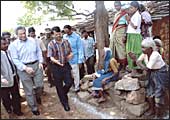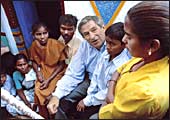 |
The
red carpet treatment laid out for him on his first, four-day visit
to the country would have made many heads of lesser states turn
green with envy. As the World Bank President Paul Wolfowitz's
25-vehicle cavalcade, complete with an ambulance and pilot car,
sped off from Hyderabad towards Mahbubnagar, security seemed to
be the state government's top concern. All along the 110-km drive,
there were policemen guarding Wolfowitz's cavalcade. For good
reason, too. Mahbubnagar is infested with Naxals, and only the
day before, on August 17, the state government had announced a
ban on the local Maoist group and seven other front organisations
and, therefore, nobody was willing to take any chances on such
a high-profile visit. Secondly, the Left parties-the Communist
Party of India and Communist Party of India-Marxist, both allies
of the ruling Congress-had taken to the streets in Hyderabad to
protest Wolfowitz's visit. Besides shouting slogans like "Wolfowitz
go back", they burnt his effigy.
But the security concerns didn't seem to
unnerve Wolfowitz. A former Defence Undersecretary in the George
W. Bush administration and American ambassador to Indonesia between
1986 and 1989, the Bank President of a little over two months
displayed great zeal on his maiden visit. Much to the dismay of
his security detail, the Bush administration appointee went about
mingling with the local people. It was his way, it seemed, of
checking out for himself the real impact of the Bank's poverty
alleviation projects in Andhra, where it has created half-a-million
self-help groups over the last five years.
 |
| Colours of India: Wolfowitz gets a
traditional welcome in an Andhra village |
 |
| Guided tour: Taking stock of the Bank's
work in Andhra Pradesh |
 |
| All ears: Up close with local self-help
groups |
Travelling in a government-provided bullet-proof
Ambassador and flanked by two security guards accompanying him
all the way from the Bank's headquarters in Washington, D.C.,
the mathematics major from Cornell University made his first halt
at the Mandal Mahila Samakya in Kosigi village of Mahbubnagar
district. After enjoying the vibrant welcome, which included a
performance by traditional dancers and drummers, Wolfowitz got
down to business at one of Andhra's most backward districts. First,
he visited the single-room house of Manneamma, the president of
Bramaramba self-help group (partly funded by the Bank) and chatted
with her and her family members for more than 30 minutes, learning
how her life and those of others in the community had changed
over the years. Not for him the statistics trotted out by the
local administration. He wanted to hear real stories from real
people.
While Manneamma explained how her life had
changed after she set up a self-help group three years ago with
Rs 25,000 (she now runs a tea shop and has three acres of land
for cultivation, and her three children go to schools), Wolfowitz
seemed visibly impressed. Later, seated with other members of
the group, he heard stories from poor illiterate women telling
him how access to cheap funds had helped them to purchase land,
animals and finance the education of their children. But the biggest
achievement for these women, he was told, was self-empowerment-knowing
their rights and knowing who to contact in times of need.
The hardline neoconservative and intellectual
architect of the Iraq war was literally moved by the inspiring
account of Magliamma, a disabled women, who had mobilised others
like herself to form a self-help group in the adjacent village
of Mushrifa. Another woman, Lata, reported that an initial loan
from her self-help group had helped raise her income. No wonder,
then, a reassured Wolfowitz not only promised to provide another
$260 million (Rs 1,144 crore) for the next three years for the
self-help groups of Andhra, but also maintained that other countries
of the world had much to learn from the Indian story. "These
women,'' he said, "have by helping one another, learnt to
go far beyond material concerns, and they have been able to defend
their rights as women... in a way that probably couldn't have
been imagined when this programme was started 10 years ago."
CAN'T BANK ON THE LEFT
Despite its noble intentions, the World
Bank continues to draw flak from the Left parties, NGOs and,
surprisingly enough, from its own evaluation committees. |
| Sometime in august
last year, the World Bank came out with its "India Country
Assistance Strategy Report", identifying the operations
the Bank intends to finance for the period 2005-08. Posted
on the net for a public debate, the report immediately came
under fire from the Left parties, academics and the NGOs,
who called for its rejection. The criticism ranged from insufficient
time (the Bank gave people only a month to post their objections),
to a lack of complete information (guidelines for lending
were not available) to pushing the privatisation agenda in
the power sector despite demonstrated problems with the model.
The Bank's plan to offer investments in hydro-electric generation
was also seen as ignoring lessons from the past-the controversy
that had erupted over the uprooting of thousands of villagers
because of the construction of Sardar Sarovar dam in the Narmada
Valley. The Bank's advocacy of a better legal framework to
enable easy sale and transfer of lands for small farmers also
did not go down too well with the NGOs.
More recently, the Bank came under fire not only for its
suggestion of privatising Delhi's crumbling water supply
system, but also for intervening to the benefit of PricewaterhouseCoopers
as the consultants for the project. Campaigners say PwC's
"blueprint for reform'' closely mirrors other Bank-funded
water privatisation plans elsewhere in the world that failed
to deliver. What the critics, however, forget is that if
the World Bank's investments aren't delivering the expected
impact in India, it is because of large 'leakages' at the
state level. Otherwise, $3 billion or Rs 13,200 crore (which
is what the Bank gave in 2004-05) should be large enough
to materially impact the lives of India's poor.
|
| |
| "THE KEY IS RURAL
DEVELOPMENT" |
|
The 10th President of the World Bank, the 61-year-old Paul
Wolfowitz, spoke to BT's Ashish
Gupta on the Bank and its India concerns. Excerpts:
Why does the World Bank set strong conditionalities
before granting loans?
Actually, conditionality is not the right word to use.
We are not here to tell the people how to run their country,
what policy they should adopt. But you must understand that
the money actually comes from taxpayers of developed countries
and some of them are not so wealthy either. We are happy
to help the poorest people in India, but we also want to
make sure that the money is used properly. It is a reasonable
demand, don't you think?
What is World Bank's policy on subsidy?
I don't think that the Bank has any policy on subsidies.
Yes, we have done analysis that tells us the adverse impact
of subsidies. Generally speaking, subsidies are very wasteful.
But if you remove subsidies at one go, people who were benefiting
from it would feel a lot of pain, especially the very poor.
Therefore, any policy on subsidy should balance the economic
considerations that subsidies are wasteful with the social
considerations that the disadvantaged people need some help.
You met the Finance Minister and the Deputy Chairman
of the Planning Commission. Have you promised them anything
as yet?
No, it wasn't that kind of a meeting. But we did discuss
significant scaling up of the Bank's assistance to India.
The assistance might be doubled in the next fiscal year.
That is the commitment, but it does not mean that it will
be spent this year itself. And we also talked about those
areas that your government is interested in. The key area
was rural development, which also includes rural infrastructure.
On Bharat Nirman-key to rural development-we have come a
long way in terms of our discussions and we will be able
to come to some agreement very soon. As far as development
of urban infrastructure, it will depend upon whether the
local constituents will be able to use the resources properly.
The third issue we are looking at is the public-private
partnership where the financial needs are very large. There
is a lot of creative thinking being done. The government
is talking about gap financing. You may have an infrastructure
project, but the primary investment is so high and the risks
so large that they need certain amount of government contribution
and we are ready to move in that direction.
Why is there a belief among many academics and NGOs
that most of the World Bank policies are dictated by the
US or western powers?
Some amount of criticism will come whatever you do. The
World Bank does represent the views of the shareholders
and the US is the biggest shareholder, but not the only
one. But my experience-a grand total of two-and-a-half months-has
shown that the US and Europe see the Bank as a way of achieving
common development objectives. The broader point is that
all the shareholders are genuinely committed to helping
countries improve the standard of living of their people,
and the Bank is the institution where that common progress
comes together.
|
Despite being the Bank's biggest beneficiary
(till the end of July 2005, the Bank had committed about $13 billion,
or Rs 57,200 crore, in 64 projects), India can still do with a
lot more assistance. As Wolfowitz himself remarked on his arrival
at the Hyderabad airport, "Despite all its increasing excellence
in information technology, industry and commerce, India remains
home to more than a quarter of the world's poor people."
In fact, the World Bank Group India Country Assistance Strategy
(2005-08) talks of partnering the government in reducing poverty,
improving the standard of living of its people, empowering communities,
improving the effectiveness of government and promoting private
sector-led growth. The $260 million commitment is a step in that
direction.
 |
| A New Hat: Impressed by the projects,
Wolfowitz has pledged more support |
The country's rural infrastructure could see
some help from the Bank. Says Wolfowitz: "The World Bank
is determined to be of help as you scale up this effort (Bharat
Nirman) to reach the millions of people needing better access
to services in rural areas." As it turned out, it wasn't
just all talk. Later when Wolfowitz visited Delhi to call on Finance
Minister P. Chidambaram and Deputy Chairman of the Planning Commission,
Montek Singh Ahluwalia, he promised $3 billion (Rs 13,200 crore)
for rural infrastructure for the next three years.
Any increase in Bank aid can be readily absorbed
by India's ambitious Bharat Nirman Project, which has an outlay
of Rs 1,74,000 crore for rural infrastructure development. Ahluwalia,
in fact, made a case for the Bank investing at least a billion
dollars in the project. That apart, Wolfowitz promised $325 million
for the Maharashtra Irrigation Project and Rs 500 crore for upgrading
drug labs in the country. The Bank may not be loved by all in
India (see Can't Bank On The Left), but as the country moves to
pull the lives of millions of its poor up by the bootstraps, the
Bank could well prove to be an invaluable ally.
|








